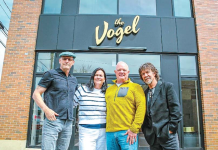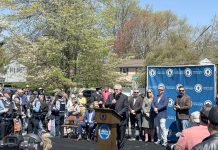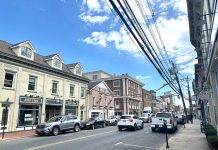By Sunayana Prabhu
SHREWSBURY – After months of opposition from residents, the Shrewsbury Land Use Board denied the Martelli Development Group’s application to replace an existing residence with a commercial building in the borough’s historic district. While residents are joyous that the “big battle in a small town” is nearly over, many are not claiming victory yet.
At a meeting Aug. 2, the board voted 6-1 to deny Martelli’s application. Martelli will have 45 days from the date the borough publishes its decision to appeal it in Monmouth County Superior Court.
“It was a great decision by the land use board for those of us who don’t want to see commercial property on Broad Street,” said Thornbrooke resident Judith Kramer. She and other residents were ecstatic the proceedings, going on since January, came to an end but are also all too aware the decision could be appealed.
Martelli had plans to renovate the existing house into a commercial office, which required a use variance. The property, located at 942 Broad St., is locally referred to as the Judd property. Martelli has a purchase contract with current property owner Michael Lynn.
Martelli has made several attempts to develop 942 Broad St. over the past six years, including building a medical office complex or 15 townhomes. Considering public sentiments, these site plans were reworked into the latest use application to replace the house with an office for the development group.
“It is a residential area, and it’s somebody’s neighborhood,” Christopher Cherbini, Shrewsbury Borough administrator said, “to put a business inside of a neighborhood, even though you call it Route 35 or Broad Street, I felt that that’s not what the ultimate master plan called for.”
The 3.44-acre parcel is heavily wooded, sits next to Manson Field and abuts the Shrewsbury Municipal Complex and the Thornbrooke community. It is close to the historic four-way intersection at Broad Street and Sycamore Avenue, dotted with landmarks like Christ Episcopal Church, the Quaker Meeting House and the historic Allen House. The speed limit on this stretch of Route 35 was recently reduced to 35 mph from 40.
Residents persisted against Martelli’s team of professional engineers, planners and the attorney who presented several testimonies throughout the proceedings. Architect James Monroe and engineer Marc Leber assured a small footprint, structural renovation that would adapt to the historic character of the area, minimal commercial activity and more. Martelli’s attorney Bernard Riley also offered to donate one acre to the borough through a deed restriction and maintain it as open space. Professional planner Veena Sawant argued that renovating the existing house into a “limited-use office building” is the most “benign” adaptive reuse of a place currently in disrepair.
None of the offers seemed to appeal to the residents, who stayed firm throughout several board meetings that ran over three hours and beyond the bedtimes of some of the Thornbrooke residents, as one noted at a previous meeting.
Residents inundated Martelli’s experts with well-researched questions, probing them on several environmental and traffic flow issues from maintaining a small commercial footprint to pedestrian traffic, construction of new sidewalks around the property, creating buffers to minimize lights on the property, traffic flow impacting the vicinity, stormwater management, and the possibility of electric generators that could cause additional noise pollution, among many others concerns.
“No one really celebrated the moment,” said Michael Nugent, a Thornbrooke resident.
“We’re in a good shape with energy levels and now we just have to kind of nail down our support for a future for that parcel other than commercial development.”
A small group of borough residents is now exploring what would be required to purchase the land, either by the borough with help from residents or with Green Acres money. The purpose would be to turn “that parcel into some kind of nature preserve or walking trail, but keeping it as open space, especially since it abuts the Manson Park and historic district,” said Kramer.
She added that in the borough’s “old master plan, there is a suggestion” that Shrewsbury would “do well to create 3.6 more acres of open space that would be usable.”
“This parcel is practically that.”
This article originally appeared in the August 24 – 30, 2023 print edition of The Two River Times.














